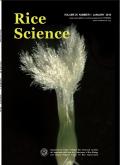Molecular and Biological Characterization of Novel Mitovirus Infecting Phytopathogenic Fungus Ustilaginoidea virens
IF 5.6
2区 农林科学
Q1 AGRONOMY
引用次数: 0
Abstract
Rice false smut (RFS), caused by the ascomycete fungus Ustilaginoidea virens (Cooke) Takahashi, is a notable panicle disease of rice. Mycoviruses represent a category of viruses capable of infecting various fungal groups, garnering interest for their potential application in the biological control of plant fungal diseases. We identified a novel positive-sense single-stranded RNA virus, named Ustilaginoidea virens mitovirus 1 (UvMV1), from an abnormal U. virens strain Uv488. The complete genome sequence of UvMV1 is 2 474 nt in length and contains a large open reading frame encoding RNA-dependent RNA polymerase. UvMV1 is classified as a new member of the genus Unuamitovirus in the family Mitoviridae based on phylogenetic analysis. It is effectively transmitted vertically through conidia of strain Uv488 and horizontally through hyphal fusion between vegetatively compatible individuals with an 80% transmission efficiency. We further demonstrated that UvMV1 significantly influenced conidiation, colony morphology, growth rate, secondary metabolite production, and the response to environmental stress in U. virens. Furthermore, qRT-PCR results aimed at detecting the expression levels of autophagy-related genes suggested that UvMV1 infection had the potential to induce autophagy in U. virens. Activation or inhibition of autophagy through chemical experiments demonstrated that UvMV1 enhances viral titers by inducing autophagy in U. virens, while inhibition of autophagy results in decreased UvMV1 titers. Transcriptome analyses consistently demonstrated that UvMV1 regulated the expression of genes associated with secondary metabolism, mycelial growth, virulence, and the mitogen-activated protein kinase signaling pathway, thereby influencing both the antiviral response and the virulence of U. virens. The data presented collectively identified a novel mycovirus responsible for inducing growth abnormalities in U. virens, and elucidated the regulatory mechanisms during mycovirus-host fungus interactions, particularly the autophagy pathway. These findings offer new perspectives and potential control strategies for managing RFS in agricultural settings.
感染植物病原真菌 Ustilaginoidea virens 的新型丝状病毒的分子和生物学特性鉴定
本文章由计算机程序翻译,如有差异,请以英文原文为准。
求助全文
约1分钟内获得全文
求助全文
来源期刊

Rice Science
Agricultural and Biological Sciences-Agronomy and Crop Science
CiteScore
8.90
自引率
6.20%
发文量
55
审稿时长
40 weeks
期刊介绍:
Rice Science is an international research journal sponsored by China National Rice Research Institute. It publishes original research papers, review articles, as well as short communications on all aspects of rice sciences in English language. Some of the topics that may be included in each issue are: breeding and genetics, biotechnology, germplasm resources, crop management, pest management, physiology, soil and fertilizer management, ecology, cereal chemistry and post-harvest processing.
 求助内容:
求助内容: 应助结果提醒方式:
应助结果提醒方式:


